Zenaida auriculata [EN-ES]
| Latin name | Observation date | Location |
|---|---|---|
| Zenaida auriculata | February 7, 2023 | Cuba |
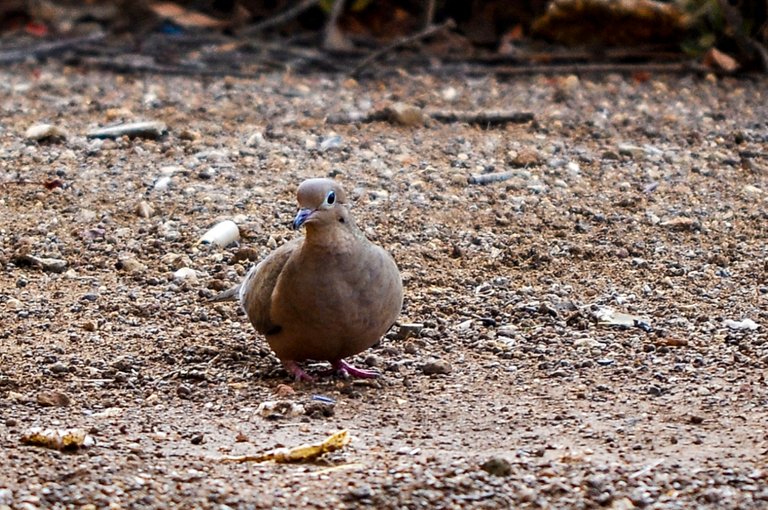
| Camera | Nikon D5000 |
|---|---|
| Lens used | Nikkor 55-200 mm |
| Filter used | None |
| Exposure time | 1/250 second |
| Aperture used | f 5.6 |
| Focal length | 200 mm |
| ISO | 200 |
| Day | February 7, 2023 |
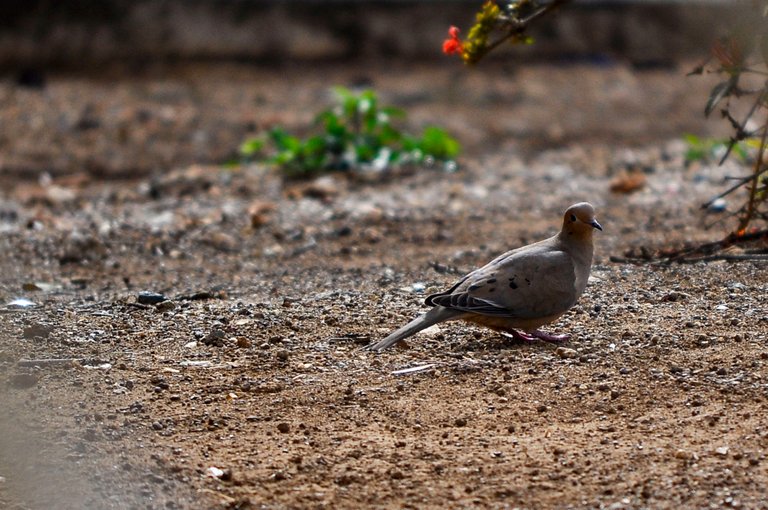
| Camera | Nikon D5000 |
|---|---|
| Lens used | Nikkor 55-200 mm |
| Filter used | None |
| Exposure time | 1/800 second |
| Aperture used | f 5.6 |
| Focal length | 200 mm |
| ISO | 200 |
| Day | February 7, 2023 |
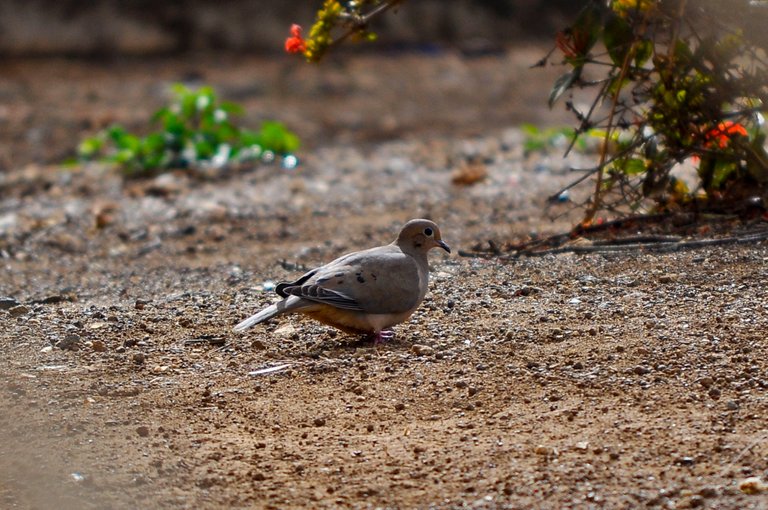
| Camera | Nikon D5000 |
|---|---|
| Lens used | Nikkor 55-200 mm |
| Filter used | None |
| Exposure time | 1/800 second |
| Aperture used | f 5.6 |
| Focal length | 200 mm |
| ISO | 200 |
| Day | February 7, 2023 |
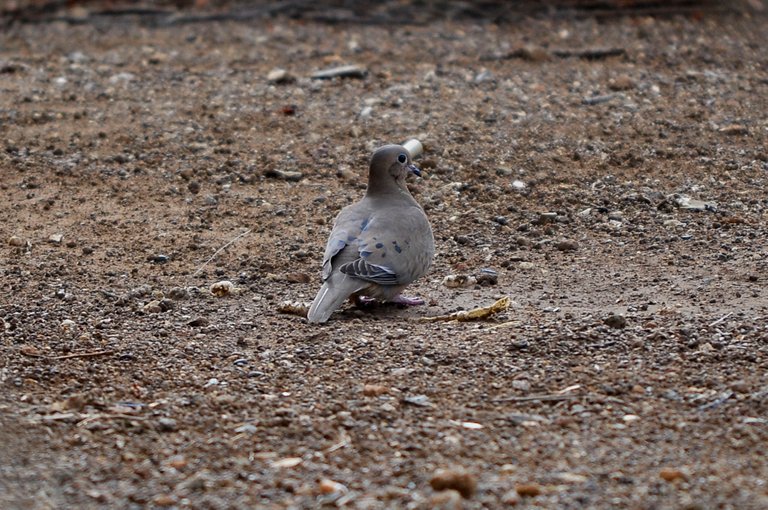
| Camera | Nikon D5000 |
|---|---|
| Lens used | Nikkor 55-200 mm |
| Filter used | None |
| Exposure time | 1/320 second |
| Aperture used | f 5.6 |
| Focal length | 200 mm |
| ISO | 200 |
| Day | February 7, 2023 |
| Link to original community |
|---|
| https://www.inaturalist.org/observations/148459570 |
| Latitude | Longitude | Map |
|---|---|---|
| 21.850181 | 78.758163 | https://www.inaturalist.org/taxa/3439-Zenaida-auriculata |
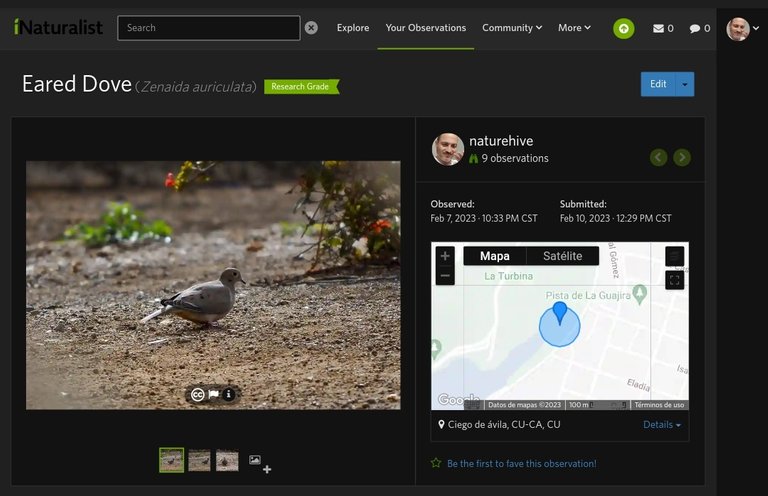


[ENGLISH] The eared dove is 24 cm (9.4 in) long with a long, wedge-shaped tail, and weighs normally about 112 g (4.0 oz). Adult males have mainly olive-brown upperpart plumage, with black spots on the wings. The head has a grey crown, black line behind the eye, and the blue-black on the lower ear coverts. These black markings give the species its English and specific names. The underparts are vinous, and the tail is tipped with cinnamon. The bill is black and the legs dark red.
The eared dove is common to abundant in savannahs and other open areas, including cultivation, and it readily adapts to human habitation, being seen on wires and telephone posts near towns in Trinidad and Venezuela, almost in all public spaces of large urban areas such as Bogotá, Colombia, and feeding near beach resorts in Tobago.
If you want to learn more about it
[ESPAÑOL] La paloma orejuda mide 24 cm (9,4 pulgadas) de largo con una cola larga en forma de cuña y normalmente pesa alrededor de 112 g (4,0 oz). Los machos adultos tienen el plumaje de las partes superiores de color marrón oliva, con manchas negras en las alas. La cabeza tiene una corona gris, una línea negra detrás del ojo y la azul-negra en las coberteras inferiores de las orejas. Estas marcas negras dan a la especie sus nombres en inglés y específicos. Las partes inferiores son vinosas y la cola tiene puntas de canela. El pico es negro y las patas de color rojo oscuro.
La paloma orejuda es común a abundante en sabanas y otras áreas abiertas, incluido el cultivo, y se adapta fácilmente a la habitación humana, se ve en cables y postes telefónicos cerca de ciudades en Trinidad y Venezuela, casi en todos los espacios públicos de grandes áreas urbanas como Bogotá, Colombia, y se alimenta cerca de los centros turísticos de playa en Tobago.


🙋🙋🙋🙋

Camera: Nikon D5000 l Lens: Nikkor AF-S 18-55 mm 1:3.5-5.6 G
Camera: Nikon D5000 l Lens: Nikkor AF-S 55-200 mm 1:4-5.6 G ED
Cámara: Nikon D5000 l Lente: Nikkor AF-S 18-55 mm 1:3.5-5.6 G
Cámara: Nikon D5000 l Lente: Nikkor AF-S 55-200 mm 1:4-5.6 G ED
🪶 All the photos and texts in this post are my authorship.
🪶 Todas las fotos y textos presentes en éste post son de mi autoría.
THANK YOU, BYE
😘

Our most common dove is all grey with a black stripe on its neck https://www.inaturalist.org/taxa/2969-Streptopelia-decaocto and lives commonly in towns and villages. The other one that lives in the Czech Republic is much prettier but shy and rarer https://www.inaturalist.org/taxa/2938-Streptopelia-turtur
https://www.inaturalist.org/observations/32774771
Those dove you show are really beautiful, in my country there are some similar to the white pigeon with a black ring on the neck, maybe I can upload to the Inaturalist platform some photos, greetings🙋
Really beautiful dove 👇👇
!discovery 35
This post was shared and voted inside the discord by the curators team of discovery-it
Join our community! hive-193212
Discovery-it is also a Witness, vote for us here
Delegate to us for passive income. Check our 80% fee-back Program